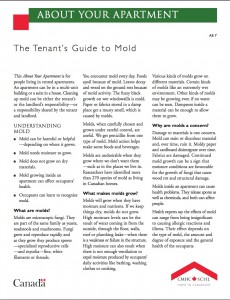 Take mold seriously! This comprehensive article on mold is as valuable today as it was when we first posted it a few years ago. It includes a very useful CMHC homeowner’s guide.
Take mold seriously! This comprehensive article on mold is as valuable today as it was when we first posted it a few years ago. It includes a very useful CMHC homeowner’s guide.
We have experienced several tenant issues with mold, currently one of the most litigious situations that any landlord can face. At Downtown Suites, we take mold very seriously and deal with it as promptly and efficiently as we can with recognized mold professionals. Unfortunately, oftentimes the property has to be evacuated and this results in loss of rent and possible arbitration for health issues with the tenants. Take it seriously!
Frequently check for evidence of mold and be cautious of any minor leaks in humid locations that can foster mold. Be careful to ensure that ventilation outlets are opened so the basement areas can “breathe”. One issue we had in a very expensive town home was caused partly by the vents being closed so there was no adequate venting.
We are including a link to the extensive CMHC information guide for you to review:
Fighting Mold: The Homeowners’ Guide
Understanding mold
- Mold can be harmful or helpful depending on where it grows.
- Mold needs moisture to grow.
- Mold does not grow on dry materials.
- Mold growing inside a home can affect the occupants.
- Occupants can learn to recognize mold.
Molds are microscopic fungi, a group of organisms which also includes mushrooms and yeasts. Fungi are highly adapted to grow and reproduce rapidly, producing spores and mycelia in the process.
You encounter mold every day. Foods spoil because of mold. Leaves decay and pieces of wood lying on the ground rot due to mold. That fuzzy black growth on wet window sills is mold. Paper or fabrics stored in a damp place get a musty smell that is due to the action of molds.
Molds can be useful to people. The drug penicillin is obtained from a specific type of mold. Some foods and beverages are made by the actions of molds. The good kinds of molds are selected and grown in a controlled fashion.
Molds are undesirable when they grow where we don’t want them, such as in homes. Over 270 species of mold have been identified as living in Canadian homes. Molds that grow inside may be different from the ones found outdoors.
What makes molds grow?
Molds will grow if we provide them with moisture and nutrients. If we keep things dry, molds do not grow.
High moisture levels can be the result of water coming in from the outside, through the floor, walls or roof; or from plumbing leaks; or moisture produced by the people living in the home, through daily activities like bathing, washing clothes or cooking. Water enters the building when there is a weakness or failure in the structure. Moisture accumulates within the home when there is not enough ventilation to expel that moisture.
Different kinds of molds grow on different materials. Certain kinds of molds like an extremely wet environment. Other kinds of molds may be growing even if no water can be seen. Dampness inside the material can be enough to allow them to grow.
Why are molds a concern?
Damage to materials is one concern. Materials get stained or discoloured, and over time they are ruined. Moldy paper and cardboard disintegrate over time. Fabrics are damaged. Continued mold growth can be indicative of moisture conditions favourable for growth of fungi that cause wood rot and structural damage.
When molds are growing inside the home, there may be health concerns. Molds release chemicals and spores.
Health experts indicate that, depending on the type of mold present in a home, the amount and degree of exposure, and the health condition of the occupant, the health effects of mold can range from being insignificant to causing allergic reactions and illness.
Pregnant women, infants, the elderly and those with health problems, such as respiratory disease or a weakened immune system, are more at risk when exposed to mold. Consult your family physician if you believe there is someone who may be at risk.
Is there a mold problem?
Molds are always found in the air outside and in all buildings. They come into the home in many ways: through open windows or doors, on clothing, pets, food or furniture. The problem starts when mold grows inside the home.
Some mold growing, for example on the window sill but not elsewhere, is not a cause of concern. You can clean the mold yourself. The presence of mold is a sign that there is too much moisture in your home, a situation which must be corrected.
Inspect the home to find the extent of the mold. (….read more on mold here in this CMHC pdf.)





